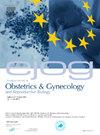Efficacy and safety of elinzanetant in vasomotor symptoms associated with menopause: A meta-analysis of randomized controlled trials
IF 2.1
4区 医学
Q2 OBSTETRICS & GYNECOLOGY
European journal of obstetrics, gynecology, and reproductive biology
Pub Date : 2025-01-30
DOI:10.1016/j.ejogrb.2025.01.050
引用次数: 0
Abstract
Objective
To evaluate the efficacy and safety of elinzanetant compared to placebo in patients experiencing vasomotor symptoms (VMS) associated with menopause.
Methods
A systematic search of PubMed, Embase, and Cochrane databases identified randomized clinical trials (RCTs) comparing elinzanetant and placebo in patients with menopause-related VMS. Statistical analyses pooled mean difference (MD) and risk ratio (RR) with 95% confidence intervals (CI) using R Studio 4.3.2. Pre-specified outcomes included frequency and intensity of VMS, quality of life, and sleep disturbance.
Results
This meta-analysis included three randomized clinical trials reporting data on 995 patients, with 551 receiving elinzanetant. The mean age ranged from 54.4 to 55.6 years. Elinzanetant significantly reduced VMS frequency (MD −3.09; 95 % CI −4.18 to −2.01; I2 = 0 %) and intensity (MD −0.32; 95 % CI −0.43 to −0.21; I2 = 39 %). Improvements in quality of life were demonstrated by reduced scores on the Menopause-Specific Quality of Life Questionnaire (MD −0.46; 95 % CI −0.63 to −0.30; I2 = 35 %) and better sleep quality measured by the Patient-Reported Outcomes Measurement Information System Sleep Disturbance – Short Form 8b (MD −4.65; 95 % CI −5.56 to −3.73; I2 = 0 %). The incidence of adverse events was similar between groups (RR 1.11; 95 % CI 0.99 to 1.25; I2 = 35 %).
Conclusion
Elinzanetant reduces the frequency and intensity of VMS and enhances quality of life and sleep quality in patients with menopause-related symptoms. Its safety profile is comparable to placebo.
求助全文
约1分钟内获得全文
求助全文
来源期刊
CiteScore
4.60
自引率
3.80%
发文量
898
审稿时长
8.3 weeks
期刊介绍:
The European Journal of Obstetrics & Gynecology and Reproductive Biology is the leading general clinical journal covering the continent. It publishes peer reviewed original research articles, as well as a wide range of news, book reviews, biographical, historical and educational articles and a lively correspondence section. Fields covered include obstetrics, prenatal diagnosis, maternal-fetal medicine, perinatology, general gynecology, gynecologic oncology, uro-gynecology, reproductive medicine, infertility, reproductive endocrinology, sexual medicine and reproductive ethics. The European Journal of Obstetrics & Gynecology and Reproductive Biology provides a forum for scientific and clinical professional communication in obstetrics and gynecology throughout Europe and the world.

 求助内容:
求助内容: 应助结果提醒方式:
应助结果提醒方式:


